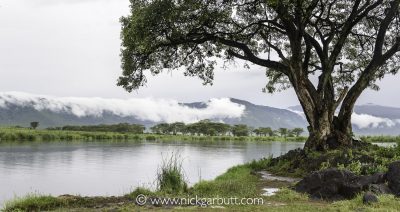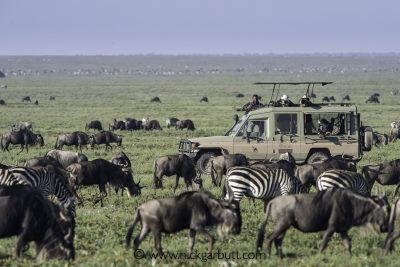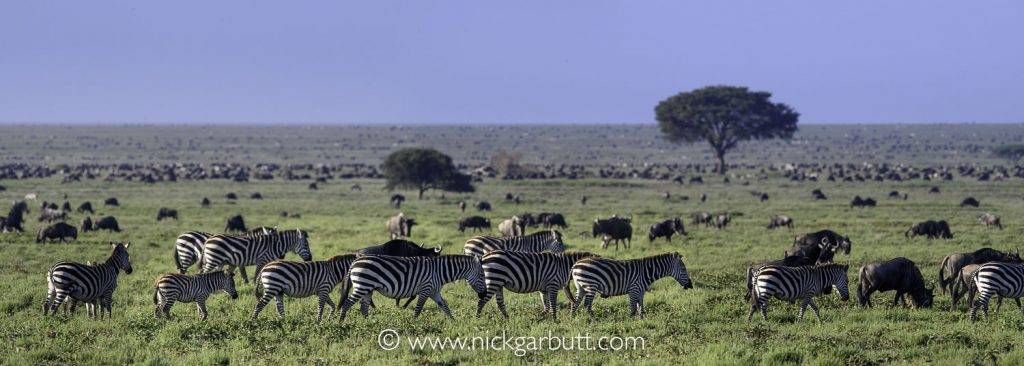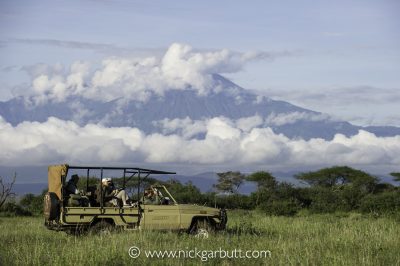Tanzania 2017 Trip Report: Southern Serengeti Migration

One of East Africa's most recognisable birds, the lilac-breasted roller
What might you regard as the greatest wildlife show on earth? An impossible subjective question of course, and one to which there are several potential worthy answers. High up the list of contenders must be the annual migration of wildebeest, zebra and other game around the Serengeti-Masai Mara ecosystem in Kenya and Tanzania.
This spectacle can be seen in various guises at different times of the year as the massing herds follow a reasonably predictable circuit around the ecosystem that ties in with the cycle of rains. I have always preferred the experience on the Tanzanian side of the border, especially in March and April when vast numbers of animals assemble on the short grass plains of the Southern Serengeti. Here tens of thousands of wildebeest give birth and then graze and nourish their calves on the rich fresh grasses of the area.
This year’s tour in late March / early April proved to be one of the best. The timing of the rains worked perfectly in our favour, meaning that our arrival on the short grass plains coincided with huge numbers of animals gathering.

A male impala in Tarangire
Our first stop, however, was Tarangire National Park which lies only three hours by road away from Kilimanjaro International Airport. It is only 7km from the main road to the park entrance and wildlife became apparent immediately on reaching the gate – mainly impala, with some Grant’s gazelles and Kirk’s dik-dik. The bush-dominated habitat , interspersed with lots of baobabs means there are many bird species not seen elsewhere in Tanzania’s northern safari circuit.
Tarangire Safari Lodge is located only 10km from the gate and commands a wonderful position overlooking the valley of the Tarangire River. In late March the valley was very green after heavy rain over the preceding weeks, consequently wildlife and mammals in particular were well dispersed. Visible from the lodge were groups of elephants dotted in the shade of some of the larger trees and the occasional Masai giraffe.

The view from the rim down into the Ngorongoro Crater
Our first game drive later in the afternoon reinforced how widely dispersed mammals were – after heavy rain large numbers move to the east and outside the park onto an area known as the Masai Steppe – the only large mammals seen with any regularity were small groupings of elephants, herds of impala and giraffe.
On our final early morning in Tarangire we concentrated efforts on a region north of the lodge, where some more open grassland areas is dotted with numerous baobabs (know locally as ‘Little Serengeti’). However, the undoubted highlight was the discovery of a beautiful, but rather skittish, male leopard resting on the lower branch of a large baobab. After watching the leopard from a distance for a while, we moved in for a closer look and the hope of getting some photos. However, the leopard almost immediately climbed higher into the tree, becoming largely obscured by branches.

This caracal in the Crater was chasing a mongoose
We then moved onto the Ngorongoro Crater. From the Noduare Park Gate at 1850mm (6,000ft) to the Crater rim flourishes montane forest, largely comprised of deciduous hardwoods, with some Giant Lobelia and Verbenia. We paused briefly at the Crater rim at about 2300m (7,500ft) to look down at one of the world’s natural wonders: way down on the Crater floor we could make out herds of white-bearded wildebeest, buffalo and zebra as well as a smattering of huge bull elephants, particularly around the marsh areas.

Huge tuskers are a feature of the Ngorongoro Crater
Turning west, we continued around the Crater rim to the western descent road and were then able to spend the final two hours of the day enjoying a taste of the Crater experience. An interesting point of note was the complete lack of grazing Masai livestock on the western side of the Crater floor. Recent changes in the regulations have now stopped allowing the Masai to graze their animals within the bounds of the Crater. Historically this was permitted to give them access to permanent water sources, however, the authorities have now provided a pipeline near the Masai villages on the Crater Rim, which means there is no longer a necessity for them to descend into the Crater.
The consequence is that wildlife is now much less wary and has quickly moved to occupy and utilise the extreme western side of the Crater floor close to the bottom of the descent road. This was immediately apparent as we reached the Crater floor, as there were large numbers of wildebeest, eland and zebra in the areas that previously they have avoided.

Bull elephants on the Crater floor
For the remainder of the afternoon we gained an impression of the extent of the diversity and quantity of wildlife that lives in the Crater. It really is a fantastic place. Not only were there large herds of the more common grazing species, but also large numbers of impressive bull elephants, some of which sport what must be some of the largest tusks of any individuals in East Africa. There were also large numbers of spotted hyenas and jackals.
However, the highlight happened at the very end of the afternoon as we were starting leave on the eastern ascent road out of the Crater, when we encountered a caracal stalking and then chasing an Egyptian mongoose. The caracal failed to catch the mongoose, but certainly put in plenty of effort in the attempt.

One of three brothers, a magnificent male lion in the Crater
The following morning we left the lodge before 6.00am in order to be at the park gate as soon as it opened. We then followed the descent road on the extreme north eastern side of the caldera. The montane forest around the rim in this area is relatively lush with a number of large tree species prominent: Flat-top Acacia (Acacia abyssinica), Red Thorn (Acacia lahai), Broad-leaved Croton (Croton macrostachyus), Nuxia congesta and Pillarwood (Cassipourea malosana). As we descended we passed many trees that were heavily draped in aerial “Barbed” Lichen (Usnea). It was around 6.45am when we reached the Crater floor.
Our route over the Crater floor, initially took us north west towards the Munge River and then around to the edge of the Mandusi Swamp. From here we moved south to near Lake Magadi and then passed through the Lerai Forest before cutting through the centre of the Crater and then turning back north and leaving via the same ascent / descent road at the north eastern corner of the Crater.

Masai in the Ngorongoro highlands
The morning proved to be a fabulous one and set the scene for wildlife watching to follow. It was clear there had been plenty of rain, which had affected the areas’ ecology. The Crater floor itself was a sea of lush green grasses and herbs that formed a thick carpet. Dotted around were occasional temporary pools of standing water, streams from the rim down into the Crater were all flowing freely and the marsh and lake areas were full.
The southern and eastern grasslands on the Crater floor were relatively thinly populated with grazing animals, with smatterings of white-bearded wildebeest, plains zebra and Grant’s gazelle. However, there were small groups of Cape buffalo visible. To the north and west in the areas adjacent to the Munge River and Madusi Swamp there were some herds of wildebeest and zebra interspersed with smaller numbers of both Grant’s and Thompson’s gazelles. On the northern and western slopes some eland were also visible.
As is so often the case, the Lerai Forest proved to be good for elephants, with several large bulls being seen and one modest sized herd of females, youngsters and a couple of small babies. On the return to central track there were several black rhino visible, including one at a modest distance away, which allowed for some meaningful photography.

Ngoitokitok lake and marsh
Later in the afternoon we drove north through the Highlands valley towards Olmoti Crater, passing the Masai village of Ireepusi. There were small numbers of zebras and one or two interesting birds including Jackson’s widowbird.
The next day we once gain left very early. It was still dark as we drove around the Crater rim with the first hints of daylight beginning to appear as we started the descent. By half way down we could make out the imposing walls of the Crater stretched in a wide arc before us. A layer of thick white cloud peeled over the eastern side of the Crater’s inner edge and where the walls were steepest leaked down towards the Crater floor. As we reached the bottom, the initial gloom of early dawn had partially lifted and we could make out most of the major features.
We again visited similar areas to the previous day, largely seeing similar things: quite early on we found a pride of lions who were resting some distance away from the road, there were encounters with groups of bull elephants and again with black rhinos. This time after the Lerai Forest, we stopped for breakfast at the Ngoitokitok marsh and lake picnic site.
After breakfast we returned to the area where the lion pride had been seen and came across the three magnificent dominant males of the pride – no doubt a coalition of brothers – walking close to the road and then on the road for several hundred meters before they continued off the road and away from view.

A flock of greater flamingos on Lake Ndutu
We left the Crater using the ascent route from the Lerai Forest and then continued around the Crater rim, before turning west and beginning the descent towards the Serengeti Plains, passing the Malanja Depression with the imposing presence of Mount Lemagrut on our left. On the lower slopes, the grassland gave way to open thorn bush that is ideal habitat for Masai Giraffe with the occasional individual being seen browsing on the lower slopes.
As we descended further and gradually began moving out onto the plains, more grazing animals became apparent – mainly wildebeest and zebra - and by the time we reached the flat plains these had become small herds. There were also Thompson’s and Grant’s Gazelles in smaller numbers. Towards the beginning of the plains we turned off the main track towards Oldupai Gorge.

Ndutu is in the heart of the African bush with no barriers
Although only brief, this visit is always interesting: a short talk by a guide introduced us to the history or the gorge and the archaeological work conducted there by the Leakey family. We then visited the museum - some of the skulls and skeletal fragments from the extinct animals of the region are fascinating.
After this we returned to the main road and continued north-west crossing the upper reaches of the river valley that gives rise to Oldupai Gorge. The source of this river is Lake Masek, some 35km away. Having crossed the river, we emerged onto the short grass plains that are continuous with the Serengeti. These were flushed green after the recent rains. Initially most animals were domestic stock (Masai sheep and goats) with only a smattering of wild species. However, to the north and west in the vicinity of Naabi Hill huge numbers of white-bearded wildebeest, with smaller herds of zebra, Grant’s gazelles and Thompson’s gazelles could be seen. In the area known as “the triangle” and north towards Naabi Hill, there were hundreds of thousands of animals dotted all over the plains. Most appeared to be milling around grazing, but there were some columns walking with greater purpose as more animals streamed into the area, where evidently the grazing was good.

Ndutu Lodge is famous for its common genets
Ndutu Lodge is situated amongst an area of large Acacia trees and overlooks the southwest shoreline of Lake Ndutu. It is a glorious and beautiful place - no fences, no barriers, just a small simple sympathetically built lodge in the heart of the bush. In the evening several common genets can be seen in the rafters of the open plan restaurant area where they are fed. This “family” has become totally habituated over the years and are now an omnipresent evening attraction at the lodge.

This lioness with three cubs around 10 weeks old was seen several times and provided some memorable photo sessions
The daily routine for the next week was largely similar. Morning drives began before sunrise just after 6.00am and this gave us 6 plus hours to explore extensive areas all around the region. We generally returned to the lodge for lunch and a short break, before heading out again in the afternoon around 4.00pm until dusk. On a couple of days, we made the decision to stay out for the whole day, taking both picnic breakfast and lunch and this allowed us to travel further afield or spend time following a particular species or event for a prolonged period.

Driving through huge herds of wildebeest and zebra on the short grass plains
Almost on a daily basis we returned to the Long Gully, Small Marsh and Big Marsh areas and the woodlands immediately adjacent to these for the simple reasons these places are often so productive and regularly have large numbers of animals moving through as well as various resident groups. There are two prides of lions that call these areas home, and we saw them several times. One pride included a female with three very small cubs (around 10 weeks old).

A Serengeti leopard strikes a pose
The open plains areas surrounding these woodlands, including “Three Trees” to the west and ‘Hidden Valley’ to the north we also repeatedly visited. At various times large columns of wildebeest were seen passing through along with smaller numbers of other grazing species. There were also numerous lion sightings in or around ‘Hidden Valley’, while the open plains were (as always) extremely productive for cheetah sightings.

This male leopard was shy but with care we were able to approach for photos
The vast open plains areas to the south and west along the Kusini and Makao tracks also proved to be excellent. The numbers of animals passing through these areas varied day by day, no doubt influenced by the fluctuating rains, but the numbers of individuals to be seen was always large. Not surprisingly this area was fruitful for cheetah sightings too.
There were a number of particularly special encounters during our stay that might be summarised as our highlights from Ndutu.

These two brothers form a dominant coalition currently controlling the Marsh Pride at Ndutu
1. Late afternoon with a lioness and her three 10-week old cubs playing in glorious golden light.
2. A prolonged sighting and encounter with a relatively tolerant caracal.
3. An early morning encounter with a pair of magnificent male lions (a brother coalition) and following them as they wandered through open woodland on the edge of the plains.
4. Massive herds of wildebeest crossing Lake Ndutu.
5. On consecutive evening two wonderful leopard sightings: the first a large male concealed in the dense foliage of a tree, the second a very tolerant female resting on a low branch of an acacia late in the afternoon.
6. Watching a female cheetah, stalk and ultimately catch a male impala on the edge of the woodland.
7. On our final morning, being out on the open plains as hundreds of thousands of wildebeest and zebra gathered.

Motion blur: zebra with wildebeest

Motion blur: wildebeest with zebra

The above three images were taken with an infra-red camera and then converted to B&W. A female cheetah with cubs surveys the southern Serengeti
After a fantastic final morning sharing the open plains with hundreds of thousands of grazing animals, we set off for our next location, Salei Plains towards the north east of the NCA. We initially back-tracked along the main track that forms the border between the NCA and Serengeti National Park, here there were still huge quantities of animals grazing and gradually moving in a westerly direction. However, once we crossed the main track, the numbers of animals started to thin out considerably.

A mass crossing of wildebeest at Lake Ndutu
As we drove north heading towards the Lemuta Hills, the grasses on the plains became even shorter and it also became noticeably drier and less green. There were still large numbers of both Thompson’s and to a lesser extent Grant’s gazelles, but no wildebeest or zebra.
The areas around Lemuta and Nasera Rock are dominated by gently undulating plains dotted with small rocky outcrops. More than anything else this area offers the feeling of incredible space and freedom – generally with not another sole (except for the occasional Masai) or vehicle to be seen.

Mass migration in the southern Serengeti: zebra and wildebeest on the short grass plains
After Nasera Rock we continued east through Ang’ata Kiti (Kiti Plains), before turning north and driving around the Losinoni Hills (part of the Gol Mountains) and on up to Ol Karien Gorge on the edge of the Salei Plains. Our delightful campsite was situated in a grove of acacia trees on the edge of a dry river bed. The view to the east out over the plains was stunning with the looming shape of Oldonyo Lengai dominating (Tanzania’s only active volcano).

Tanzania's only active volcano Oldonyo Lengai looms over the Salei Plains and these Masai giraffe
It was clear there had been no rain in the area for some time as most of the grasslands were still parched and brown, consequently there were no large herds of grazing animals. Normally in early April the area would be green and the plains beneath Oldonyo Lengai would be covered in wildebeest and zebra. However, there were reasonable numbers of gazelles, both Thompson’s and Grants, plus numerous giraffes on the plains and especially around the edges of the woodland.

Rüppell’s griffon vultures circle over Ol Karien Gorge
Our first morning was spent walking through Ol Karien Gorge, where huge numbers of Rüppell’s Griffon Vultures nest on the cliffs (it is thought the entire Serengeti population uses this and a neighbouring gorge). Because it was so dry, the local Masai who were taking livestock to the only permanent water sources in the area was also using the gorge extensively.
In the afternoon there was an opportunity to walk through the woodland on the edge of the open plains, where numerous giraffe were browsing. This presented some interesting photography opportunities with the giraffe and Oldonyo Lengai in the background.
The following day we set off very early to drive the 30km or so across the plains to the east to the edge of the Rift Valley escarpment. From this spectacular vantage, with Oldonyo Lengai close by on our right hand side, we could look down on the southern end of Lake Natron.

Our head drive guide Jombi with Oldonyo Lengai behind
The following day after an early breakfast in camp we began the long drive back towards the Ngorongoro Highlands, initially heading south over the plains and passing by the end of Oldupai Gorge to the west of the Olbalbal Depression. We then re-joined the main track to begin the ascent back into the highlands, on the way encountering the occasional giraffe feeding in whistling thorn acacia bushes. From the NCA gate it was less than an hour back through the Karatu Valley to Lake Manyara, then on past Mto Wa-Mbu and eventually back to the Trans-Africa highway. Turning north east we continued on through Arusha, past Mount Meru and on towards Mount Kilimanjaro. Shortly after the international airport junction, we turned north on the final run up to Ndarakwai on the north-western slopes of Kilimanjaro.
It was late afternoon-early evening as we approached the ranch and a real surprise was in store when a very large herd of elephants appeared. From their direction of movement it seemed likely they had come from the Mount Meru area and were heading towards Kilimanjaro.

On the short grass plains spotted hyenas make short work of a younf wildebeest
Ndarakwai Camp is a permanent tented lodge on Ndarakwai Ranch. With views of Mt. Meru, the camp is nestled in a protected forest of fig trees and yellow-barked acacias that line the seasonal Ngare Nairobi River. Ndarakwai is a Masai word for native cedar trees that grow in the area. The area was farmed and ranched when Tanganyika was a German colony and some of the original boundary markers remain.
Ndarakwai was one of a number of “West Kili” farms that was nationalized in the mid 1970’s and subsequently suffered unregulated grazing, tree cutting, and rampant poaching, decimated the ranch’s grasslands and droving out the resident elephant sand other wildlife. The area fast deteriorated into a barren waste-land.
In 1995, the current owners committed to restoring the Ranch’s health to support wildlife populations – at the time a bold experiment in self-sustaining conservation and then unique in Tanzania. This has been a qualified success. With protected trees and vegetation, there is now reduced run-off after the rains, the water table has risen and grass resources improved. Removing the large herds of cattle has allowed the grasslands to flourish involving a significant increase in the diversity of grass species (although recent increased encroachment of Masai cattle has cause significant issues). Consequently there are now permanent and semi-permanent populations of herbivores that include, elephants, zebra, eland, giraffe, wildebeest, gerenuk, lesser kudu, bushbuck and mountain reedbuck. Cheetahs are infrequently seen and lions have become seasonal residents since 2010.

A male bushbuck around the camp at Ndarakwai
The pace of the trip dropped appreciably for a final three days as we relaxed into the ambience at Ndarakwai. There were still early morning game drives, with a return to the lodge for breakfast. After breakfast, there were opportunities to walk and enjoy the surrounds on foot (a welcome change from being in a vehicle) and then in the afternoon there were further opportunities for walks or drives. After dinner, night drives offered a new perspective and the chance to see species not normally encountered on East Africa trips where driving at night is forbidden in national parks.
There was much wildlife to see around the camp, with both vervet and blue monkeys in residence and habituated bushbuck regularly showing. In the woodland immediately adjacent to the camp, large numbers of impala regularly gathered. After dark there were visits by greater bushbabies to a feeding platform adjacent to the bar area.

A game drive in the shadow of Mt Meru at Ndarakwai
While the game viewing was not as intense as we’d previously experienced in the NCA and Serengeti, it was still rewarding. Notable were sightings of lesser kudu and mountain reedbuck that we had not previously seen during the trip. Bird watching was also very rewarding with many resident species being different from those encountered in the NCA / Serengeti.
The night drives certainly did offer a brief window into a hitherto unseen world. Nocturnal animals included spinghares and large-spotted genets and also two splendid red spitting cobras. Sadly we failed to encounter the one animal everyone wants to see after dark – the aardvark – although we did see fresh evidence in the form of new burrow diggings.
I will next be offering tours to Tanzania in 2019 (Northern Serengeti Migration) and 2020 (Southern Serengeti Migration). Please click here to register interest.
